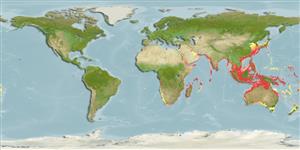Environment: milieu / climate zone / depth range / distribution range
Ökologie
seewasser; brackwasser demersal; ozeanodrom (Ref. 51243). Tropical
Indo-West Pacific: Red Sea and Persian Gulf to South Africa, east along the continental shores to western Pacific, from Japan to Australia (Ref. 11441). Southeast Atlantic: south coast of South Africa.
Size / Gewicht / Alter
Maturity: Lm ? range ? - ? cm
Max length : 45.0 cm SL Männchen/unbestimmt; (Ref. 559)
Rückenflossenstacheln (insgesamt) : 0; Rückenflossenweichstrahlen (insgesamt) : 11 - 13; Afterflossenstacheln: 0; Afterflossenweichstrahlen: 10 - 12. Body covered with prickles. Prickles on back extending from nape to caudal peduncle (Ref. 559).
Mainly marine, occasionally enters estuaries (Ref. 4833). Occurs over sandy bottoms, often on coastal reefs; feeds on a variety of marine invertebrates (Ref. 68964).
Life cycle and mating behavior
Geschlechtsreife | Fortpflanzung | Ablaichen | Eier | Fecundity | Larven
Smith, M.M. and P.C. Heemstra, 1986. Tetraodontidae. p. 894-903. In M.M. Smith and P.C. Heemstra (eds.) Smiths' sea fishes. Springer-Verlag, Berlin. (Ref. 4919)
IUCN Rote Liste Status (Ref. 130435: Version 2024-2)
Bedrohung für Menschen
Poisonous to eat (Ref. 559)
Nutzung durch Menschen
Fischereien: nicht kommerziell; Aquarium: Kommerziell
Tools
Zusatzinformationen
Download XML
Internet Quellen
Estimates based on models
Preferred temperature (Ref.
123201): 19.8 - 28.4, mean 26.7 °C (based on 1253 cells).
Phylogenetic diversity index (Ref.
82804): PD
50 = 0.5005 [Uniqueness, from 0.5 = low to 2.0 = high].
Bayesian length-weight: a=0.02239 (0.01375 - 0.03645), b=2.86 (2.73 - 2.99), in cm total length, based on LWR estimates for this species & Genus-body shape (Ref.
93245).
Trophic level (Ref.
69278): 3.7 ±0.4 se; based on size and trophs of closest relatives
Widerstandsfähigkeit (Ref.
120179): mittel, Verdopplung der Population dauert 1,4 - 4,4 Jahre. (Preliminary K or Fecundity.).
Fishing Vulnerability (Ref.
59153): Moderate vulnerability (42 of 100).
